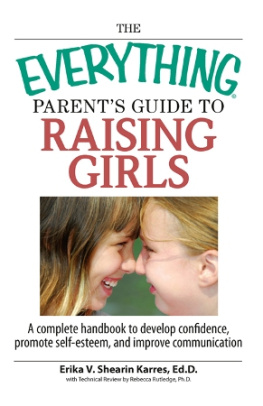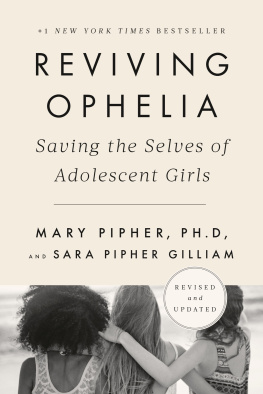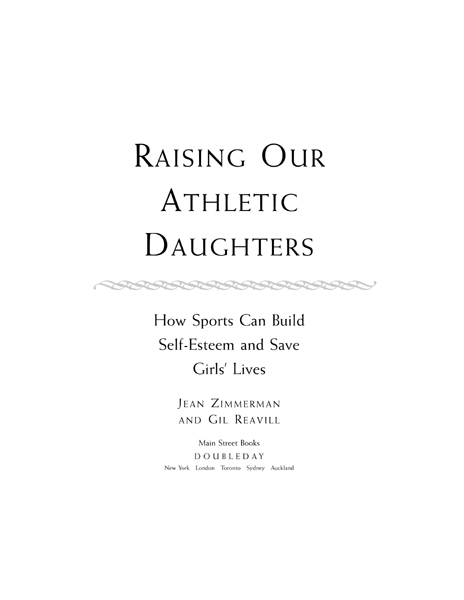
A M AIN S TREET B OOK
PUBLISHED BY DOUBLEDAY
a division of Random House, Inc.
1540 Broadway, New York, New York 10036
M AIN S TREET B OOKS , D OUBLEDAY , and the portrayal of a building with a tree are trademarks of Doubleday, a division of Random House, Inc.
Raising Our Athletic Daughters was originally published in hardcover by Doubleday in November 1998.
The Library of Congress has cataloged the Doubleday edition as follows:
Zimmerman, Jean.
Raising our athletic daughters: how sports can build self-esteem and save girls lives / Jean Zimmerman and Gil Reavill.
p. cm.
1. Sports for womenSocial aspectsUnited States. 2. Women athletesUnited StatesSocial conditions. 3. Sex discrimination in sportsUnited States. 4. Self-esteem in adolescenceUnited States. I. Reavill, Gil, 1953 . II. Title.
GV709.18U6Z55 1998
796.082dc21 98-7639
eISBN: 978-0-307-80865-3
Copyright 1998 by Jean Zimmerman and Gil Reavill
All Rights Reserved
v3.1
For Maud
Contents
CHAPTER 1 Leveling the Field
Girls Are Ready for SportsAre Sports Ready for Girls?
CHAPTER 2 Throwing Like a Girl
Sports and Your Preschool Daughter
CHAPTER 3 A Game of Her Own
Grade School and Team Sports
CHAPTER 4 Reclaiming the Court
Girls Basketball Comes of Age
CHAPTER 5 Soul Strengthening
Sports During the Ophelia Years
CHAPTER 6 A Question of Heart
Saving the Lives of Girls Through Sports
CHAPTER 7 When Sports Fail Girls
If Your Daughter Drops Out
CHAPTER 8 Going to Extremes
Your Daughter and Nontraditional Sports
Preface
As parents, as educators, as a society we are searching for answers in the late 1990s, when the cultural environment we provide for our children, and especially for our daughters, seems increasingly threatening and malignant. Weve been troubled by a picture painted of adolescent girls today which indicates that our daughters lose something of themselves as they cross the threshold to adulthood, an essential part of the self that a leading theorist of female adolescence, Carol Gilligan, has labeled voice.
A wake-up call for many parents came with the widespread dissemination of a survey report by the American Association of University Women (AAUW) in 1992. Shortchanging Girls, Shortchanging America is only one of a series of studies that have painted a dark picture of the way our society treats its daughters. The survey found a troubling downward arc to related aspects of girls lives as they continue through secondary school. They experience a larger drop in self-esteem than do boys, and as a result are more likely to lose interest in activities that challenge them, less likely to believe in their own abilities, and less likely to question teachers even when they believe the teachers are wrong.
Other research has reinforced the findings of the AAUW report. Most recently, the Commonwealth Funds Survey of the Health of Adolescent Girls, conducted in 199697 by Louis Harris and associates, recorded the responses of 6,748 boys and girls in grades five through twelve. Two of the surveys key findings were that girls are at a significantly higher risk than boys for suffering depressive symptoms and that girls lose their self-confidence as they mature, in contrast to boys, who gain in self-confidence as they grow older.
Clearly, there is a pronounced difference in the way young girls and young boys respond to modern life. The life choices of too many of our daughters are compromised by drug and alcohol abuse, early pregnancy, sexually transmitted diseases, eating disorders, self-mutilation, depression, and suicide. For many, concerns about body image become almost an obsession. We give radically different messages to our daughters and our sons, with often tragic results. We are raising a nation of Ophelias, to use a metaphor made popular by clinical psychologist and author Mary Pipher, who describes our culture as girl poisoning.
But one source of optimism registers against this bleak background. Our daughters are pouring onto the playing fields of this country in unprecedented numbers. There is a growing awareness that girls enjoy sports and that sports are good for girls. New evidence is developing which indicates that girls who play sports tend to avoid the physical, psychological, and social pitfalls of modern adolescence. For a number of reasons, playing sports empowers girls.
But something is still not right. For girls today, the desire and the readiness to play are there, but the way is often blocked. Raising an athletic daughtereven in this era of ferocious WNBA court pounders and the triumph of female athletes at both the 1996 Atlanta and 1998 Nagano Olympic Games, when USA team soccer players have achieved household icon statusparents may experience and observe situations that are disconcerting, if not disturbing. Twenty-five years after the passage of Title IX, the law that mandates equal resources for girls and boys athletic programs, stubborn disparities still exist. It can be as simple as the number of sports available for girls in your area, either in the school system or outside of school. Boys might be able to participate in soccer, baseball, football, basketball, swimming, hockey, martial arts, while for girls there may be only basketball, gymnastics, swimming, and soccer. Girls locker rooms always seem to be smaller, their practice times less convenient, and their games likely to be scheduled on school nights, when attendance is sparse, rather than on crowd-friendly weekends. The girls teams carpool, the boys teams get the hired bus.
The national media offer only minimal news coverage of our daughters sports heroines or of the womens teams they follow. Studies reveal that more than 95 percent of national sports coverage pertains to male athletes. Athletic girls lack female role models. Even if your daughter loves sports and gets a chance to play, her coaches might be all men.
Our daughters drop out of sports at much higher rates than our sons, and it tends to happen right on the cusp of adolescence, when girls most need the benefits athletics can provide. Too many parents have the experience of seeing their child get involved with some kind of activitysoccer, say, or gymnasticswhen she is in elementary school, only to have her announce her intention to quit when she reaches junior high. While a third of high school freshman girls play sports, that percentage drops to 17 percent in their senior year.
Some parents may be surprised by the characterization of American girls today as eager to play sports. They might see their daughters spending much more time loafing around the house watching TV than engaging in any kind of physical exertion. This is the source of a contemporary paradox: at a time of spiraling interest in sports for girls and women, physical activity among our children is dropping precipitously. Since 1982, there has been a 21 percent plunge in the number of teenagers who exercise regularly. Its as if our society is made up of two cultures, playing-field culture and television-watching culture, and the two of them are drifting inexorably apart.















